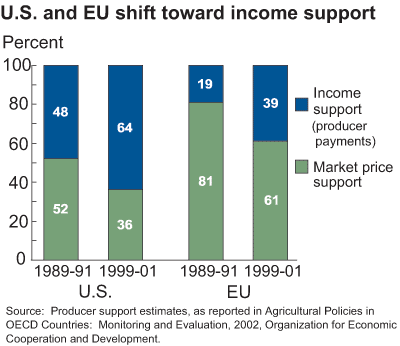Are U.S. And EU Agricultural Policies Becoming More Similar?
- by Mary Anne Normile
- 6/1/2003
Throughout much of the post-World War II period, agricultural policy in the U.S. and European Union (EU) has focused on supporting farm income primarily through price supports. Both countries supported commodity prices through purchase and storage of surplus commodities. The U.S. relied more on producer loans secured by commodities and acreage controls, while the EU relied more on export subsidies to dispose of surpluses. Both the U.S. and the EU have significantly changed their commodity policies in the past decade. While their policies have evolved in similar directions in some respects, important differences remain.
Both the U.S. and the EU have reduced their reliance on price support for several commodities for the same reasons: to improve their competitiveness, reduce burdensome stocks associated with high support prices, and rein in rising costs of operating commodity programs. Both countries now make greater use of income support through payments to producers.
Lower support prices and government purchases have reduced the need for surplus disposal, including export subsidies. Since 1995, U.S. use of export subsidies has been limited essentially to dairy products and poultry. The EU continues to use export subsidies for many price-supported commodities, although World Trade Organization (WTO) obligations have required the EU to reduce subsidy levels.
Despite similarities in policy changes, EU and U.S. policies differ. The EU maintains a higher overall support level to its farm sector and relies more on price support than does the United States. Although some EU support prices have been reduced, higher tariffs contribute to market price support by preventing the entry of lower priced imports.
Both U.S. and EU agricultural policies will continue to respond to domestic needs, the international environment, and obligations under trade agreements. In addition, public pressure on broader issues, including environmental protection, rural development, and food safety, is increasingly shaping agricultural policy.
You may also like:
- European Union. (n.d.). U.S. Department of Agriculture, Economic Research Service.
- Farm & Commodity Policy. (n.d.). U.S. Department of Agriculture, Economic Research Service.


